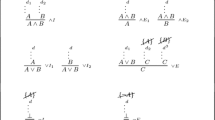Abstract
The aim of this paper is to provide a definition of the the notion of complete and immediate formal grounding through the concepts of derivability and complexity. It will be shown that this definition yields a subtle and precise analysis of the concept of grounding in several paradigmatic cases.

Similar content being viewed by others
Notes
For the sake of clarity, let us note that grounding might also be seen as a sentential operator, rather than a relation. For a detailed discussion of these issues see Correia and Schnieder (2012).
We work with multisets rather than with sets because, as will become evident later on, we need to take into account the number of occurrences of each formula of M.
For a detailed analysis of Bolzano’s complexity constraint see Rumberg (2013).
From now on \(\circ \) \(=\) \(\wedge , \vee \).
We omit the formal definition of this notion for the sake of brevity.
The relation \(\cong \) as defined only captures some aspects of the informal notion of “being about the same thing”. A more thorough attempt at capturing this notion would perhaps add an item stating that formulas of the form A, \(A\wedge A\), \(A\wedge A\wedge A\), ... , as well as formulas of the form A, \(A\vee A\), \(A\vee A\vee A\), ..., fall under the relation \(\cong \), since they clearly concern the same issue. Doing so would not be difficult, and involve minimal changes in the discussion and points made below. However, we prefer not to do it for the following reason: formulas of the form \(A\wedge A\), \(A\wedge A\wedge A\) \(\dots \), as well as formulas of the form \(A\vee A\), \(A\vee A\vee A\), \(\dots , \) are rather peculiar formulas, not very significant in the framework of a theory of grounding. Therefore, adding to Definition 4.6 an item concerning them would just burden the definition without providing any new significant insight.
In Bolzano a similar idea of condition can be found, see Bolzano (2014, Sect. 222, p. 389).
Let us note that in Correia (2014) we can find a similar idea for the logic of conceptual grounding.
References
Berg, J. (1962). Bolzano’s logic. Stockholm: Almqvist and Wiksell.
Betti, A. (2010). Explanation in metaphysics and Bolzano’s theory of ground and consequence. Logique et analyse, 211, 281–316.
Bolzano, B. (1973). Theory of science: A selection, with an introduction. Dordrecht: D. Riedel.
Bolzano, B. (2014). Theory of science. Oxoford: Oxford University Press.
Bolzano, B. (1996). Contributions to a more well founded presentation of mathematics. In William Bragg Ewald (Ed.), From Kant to Hilbert : A source book in the foundations of mathematics (pp. 176–224). Oxford: Oxford University Press.
Buhl, G. (1958). Ableitbarkeit und Abfolge in der Wissenschaftstheorie Bolzanos. Koelner Universitätsverlag [PhD Thesis, Mainz 1958].
Casari, E. (1987). Matematica e verità. Rivista di. Filosofia, 78(3), 329–350.
Correia, F. (2010). Grounding and truth-functions. Logique et Analyse, 53(211), 251–279.
Correia, F. (2014). The impure logic of conceptualistic grounding. In Recent work on the logic of grounding workshop, Oslo.
Correia, F. (2014). Logical grounds. Review of Symbolic Logic, 7(1), 31–59.
Correia, F., & Schnieder, B. (2012). Grounding: an opinionated introduction. In F. Correia & B. Schnieder (Eds.), Metaphysical grounding (pp. 1–36). Cambridge: Cambridge University Press.
Daily, C. (2012). Scepticism about grounding. In F. Correia & B. Schnieder (Eds.), Metaphysical grounding (pp. 81–100). Cambridge: Cambridge University Press.
de Rosset, L. (2013). What is weak ground? Essays in Philosophy, 14(1), 7–18.
Fine, K. (2010). Some puzzles of ground. Notre Dame Journal of Formal Logic, 51(1), 97–118.
Fine, K. (2012). Guide to ground. In F. Correia & B. Schnieder (Eds.), Metaphysical grounding (pp. 37–80). Cambridge: Cambridge University Press.
Fine, K. (2012). The pure logic of ground. Review of Symbolic Logic, 25(1), 1–25.
Lewis, D. (1973). Causation. Journal of Philosophy, 70(3), 556–567.
Litland, J. E. (2013). On some counterexamples to the transitivity of grounding. Essays in Philosophy, 14(1), 19–32.
Nozick, R. (1981). Philosophical explanations. Cambridge, MA: Harvard University Press.
Paoli, F. (1991). Bolzano e le dimostrazioni matematiche. Rivista di Filosofia, LXXXIII, 221–242.
Rumberg, A. (2013). Bolzano’s theory of grounding against the background of normal proofs. Review of Symbolic Logic, 6(3), 424–459.
Schnieder, B. (2010). A puzzle about ‘Because’. Logique et Analyse, 53(4), 317–343.
Schnieder, B. (2011). A logic for ‘Because’. Review of Symbolic Logic, 4(03), 445–465.
Sebestik, J. (1992). Logique et mathematique chez Bernard Bolzano. Paris: J. Vrin.
Tatzel, A. (2002). Bolzano’s theory of ground and consequence. Notre Dame Journal of Formal Logic, 43(1), 1–25.
Troelstra, A. S., & Schwichtenberg, H. (1996). Basic proof theory. New York: Cambridge University Press.
Acknowledgments
I wish to thank Brian Hill for the patience and the care that he has dedicated to this paper and for his hints on the notion of g-complexity. I also wish to thank the two anonymous referees for their insightful remarks that have helped me to improve the paper.
Author information
Authors and Affiliations
Corresponding author
Rights and permissions
About this article
Cite this article
Poggiolesi, F. On defining the notion of complete and immediate formal grounding. Synthese 193, 3147–3167 (2016). https://doi.org/10.1007/s11229-015-0923-x
Received:
Accepted:
Published:
Issue Date:
DOI: https://doi.org/10.1007/s11229-015-0923-x




